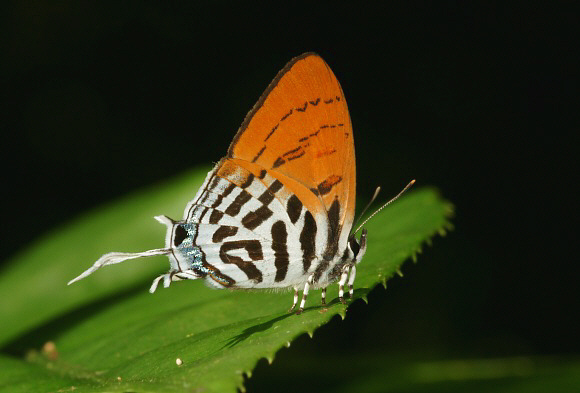
Introduction
There are 12 species in the genus Ravindra, 11 of which occur on Borneo, and 10 in West Malaysia.
“The genus is remarkable for the occurrence of pairs of species of which one is comparatively large and has secondary sexual characters in the male, and the lacks secondary sexual characters and, in both sexes resembles a dwarf female of the larger species.” ( Cowan, 1974 ).
The various species all have long tails, and on the underside hindwings feature a prominent pattern of black or brown markings on a white background. The underside forewings are some shade of brown or orange, depending on the species. On the upperside the males of most species are dark brown but this colour is almost obscured by extensive metallic blue or purple scales. The females lack the metallic sheen and are very dull by comparison, although some such as theda and niasica have patches of orange on the forewings. Most species feature a large patch of white on the outer area of the upperside hindwings.
Drupadia ravindra is the commonest and the most beautiful of the genus. It produces several very attractive subspecies such as boisduvalii from Thailand, and caesarea from Nias – the males of both of these have bright red patches on the forewings, and hindwings covered in iridescent scales that change hue from turquoise to sky blue depending on lighting conditions and angle of view.
The Common Posy is found on mainland Asia from Myanmar to West Malaysia and Vietnam. It also occurs on most islands in Indo-China including the Philippines, Palawan, Sumatra, Borneo, Java, Bali and Nias, but is not found east of the Wallace Line ( an imaginary line described by the great explorer and naturalist Alfred Russell Wallace, which separates the zoological regions of Asia from those of Australia and Papua New Guinea ).
Habitats
This species, like other members of the genus, is found in primary and secondary rainforest at altitudes between sea level and about 600 metres.
Lifecycle
According to Corbet & Pendlebury the butterfly has been bred in Malaysia on Albizia falcata and Derris scandens. Larvae have also been found on other Fabaceae including Saraca thaipingensis, and are attended by ants of the genus Pheidole.
When fully grown the larva is a very pale olive colour, and has a reddish brown dorsal stripe which widens considerably along the middle segments, forming a diamond shaped saddle.
Adult behaviour
The butterflies commonly settle on tree foliage at a height of 2-3 metres. When at rest they usually hold their wings erect or slightly apart, and oscillate their hindwings, causing the tails to “wriggle”, which draws the attention of predators to the tail of the butterfly rather than it’s head, diverting the attack and often allowing the butterfly to escape with nothing worse than a torn hindwing.
